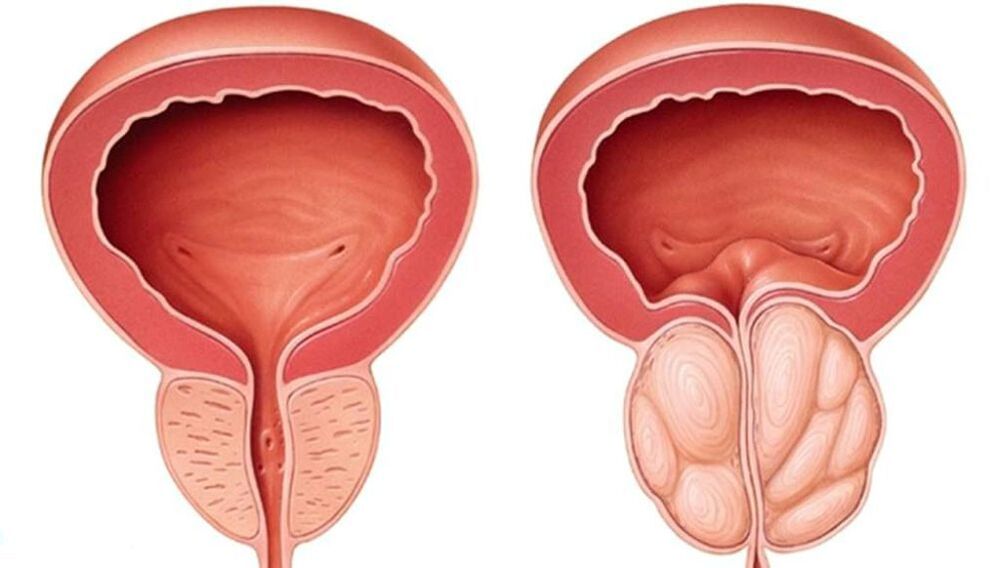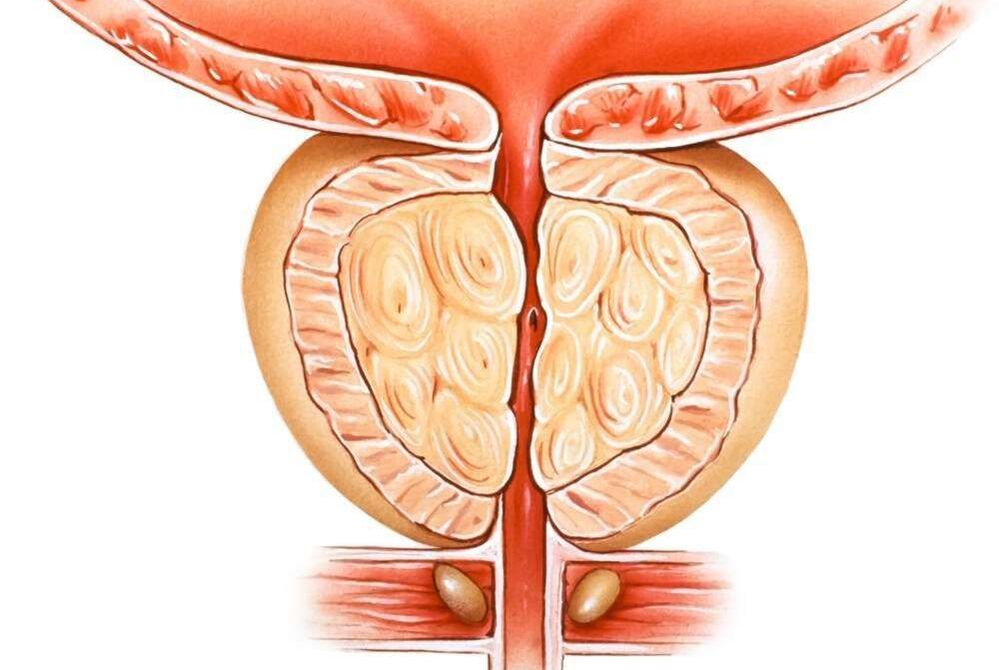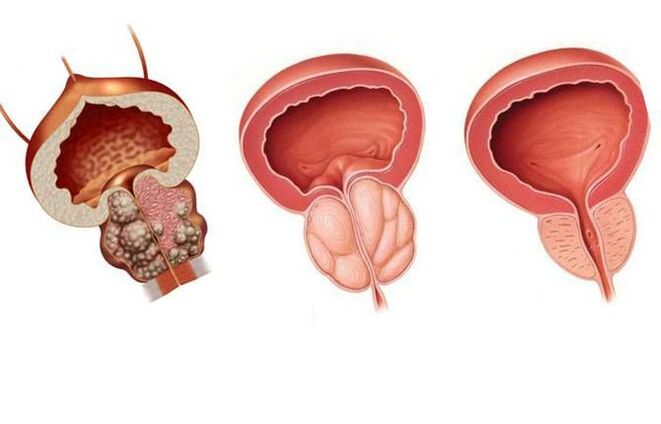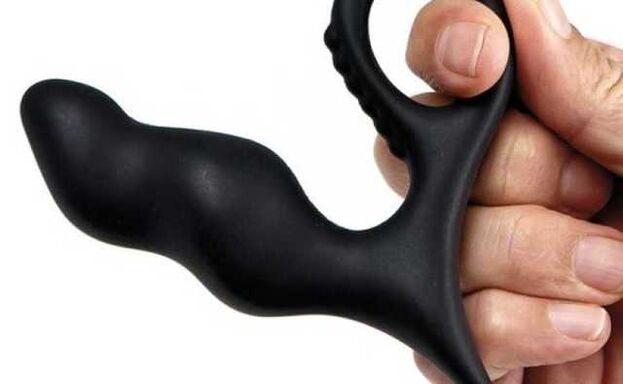Prostatitis is an inflammation of the prostate gland caused by various infections. It often takes place in an acute form and is accompanied by an increase in temperature up to 37-38 ° C, pain in the perineum and problems with urination.

Untreated acute prostatitis becomes chronic and is the most common in this condition. In this case, the symptoms are less pronounced (pain in the lower abdomen, when urinating, sexual disorders, general weakening of the body) or are completely absent. However, the consequences can be very serious. The inflammatory process is directly related to potency problems and is expressed in a decrease in libido and the cessation of orgasm.
Neglected infection dramatically increases the chance of developing complications. These are especially diseases such as:
- pyelonephritis;
- cystitis;
- prostate abscess;
- BPH;
- infertility.
Such consequences can be avoided if you consult a doctor in time. Take care of your health now - and in return you will receive excellent health, psychological comfort and increased self-esteem, the quality of sexual relations.
Causes of prostatitis
This question is important not only because many men face this problem, but also because most of them do not understand where they got this disease.
Causes of prostatitis in men:
- Sexually transmitted infections.
- Inflammatory diseases of the urethra caused by conditionally pathogenic flora.
- Sexual dysrhythmia is an irregular, unbalanced sex life.
- Physical inactivity is a sedentary lifestyle.
- Urolithiasis disease.
- The presence of foci of chronic infection in the body (chronic tonsillitis, pharyngitis, sinusitis, proctitis and paraproctitis, etc. ).
- Abuse of alcohol and spicy food.
- Constipation.
- Hypothermia.
- Pathology of the lumbosacral spine and spinal cord - due to violation of the innervation and trophism of the prostate.
Why does prostatitis occur when you have an STI? The pathogens of genital infections, especially gonococcus, trichomonas, chlamydia, ureaplasma and mycoplasma, initially affect the urethra in men and cause genital urethritis. But, like all living microorganisms, these infections actively multiply in their favorable conditions, which are the mucous membranes of the urethra and prostate ducts.
Of course, if the patient went to a urologist or venereologist in time, underwent an examination for STDs, revealed the presence of a sexual infection and cured it, then there will be no reason for the occurrence of prostatitis. Everything ends with healing at the stage of anterior urethritis. But with an advanced form of the disease, with a formal approach to the treatment of sexually transmitted diseases, when they try to cure them only with broad-spectrum antibiotics and are not cured, the microbes penetrate the back of the urethra. and prostate gland, causing inflammation, i. e. prostatitis, and more often primary-chronic at the same time. In this case, it is very easy to avoid the development of prostatitis, absolutely everything depends on the patient himself.
Everything you need:
- Seek medical help immediately at the first sign of discomfort in the urethra
- Get tested for STIs as recommended by your urologist
- Engage in comprehensive treatment of identified sexually transmitted infections
- After treatment, perform control tests to determine whether there is a sexually transmitted infection not only in the urethra, but also in the secretions of the prostate.
- And it is best to do medical prophylaxis in the clinic after casual sex, even before the symptoms of STDs appear, and protect yourself and your loved ones from sexually transmitted diseases in general, and from the cause of prostatitis in particular.
Symptoms of prostatitis
How to recognize or suspect prostatitis for an ordinary person, because its symptoms are very similar to many diseases of the urogenital system and even other organs? How is prostatitis manifested? What are the first signs and how do they behave with the progression of the disease. This is what we will talk about in this article.
What other diseases can be confused with prostatitis:
- Sexually transmitted infections (STDs) are the most common situation when a man comes to a venereologist after a casual relationship and thinks he has an STI. And actually the prostate gland is inflamed.
- Urolithiasis can cause similar symptoms, but it can also trigger an inflammatory process in the prostate.
- Cystitis is rare in men, but the symptoms are very similar to prostatitis.
- Pyelonephritis - inflammation of the renal pelvis has some common symptoms with inflammation of the prostate.
- Diseases of the scrotum (epididymitis, orchitis, varicocele) - difficulties and pains of the scrotum with these diseases, including prostatitis.
- Diabetes - patients notice increased urination, as in prostate diseases, but there is no slow flow, and the amount of urine is normal or even increased.
- Other diseases of the prostate: prostate cancer and adenoma (benign hyperplasia).
- Urethritis.
- Diseases of the rectum - fissures, hemorrhoids, tumors.
- Diseases of the lumbosacral spine.
In order to establish the correct diagnosis, the urologist must not only know the symptoms of prostatitis very well, but must also be able to correctly prescribe tests and other diagnostic tests, as well as properly evaluate their results.
So, look out for signs or symptoms of prostatitis:
Group 1 is the pain syndrome. That is, the occurrence of pain in the perineum, groin, lower abdomen, scrotum, penis, rectum, sacrum, coccyx, inner thighs. It can be just an aching, pulling, pressing sensation, or rather sharp, throbbing, strong pains. Sometimes a man simply complains of some discomfort in these areas, both during and outside of urination. The aching pain often gets worse when you sit in a chair or in a car for a long time.
In case of chronic, indolent prostatitis, the pain may decrease after intercourse. If the inflammation is strongly expressed in the prostate or large calcifications (stones) form in the gland, pain may occur during ejaculation.
Group 2 symptoms - urinary disorders. Urination increases, first at night and then throughout the day. The flow of urine becomes slow, the volume of individual doses decreases, the transparency of urine decreases, blood may appear. In case of severe swelling of the prostate or fibrosis of the gland around the urethra, emptying the bladder is particularly difficult. A person has to strain, wait a little while to urinate.
Group 3 - violation of sexual function. In the initial stages of prostatitis, sexual desire, increased excitement and premature ejaculation are slightly increased. Also, due to the decrease in the production of sex hormones, the libido decreases, the erection falls. A man is either unable to have sex, or once he has started, he is unable to finish it. But even when ejaculation occurs, the orgasm is dull or hardly felt at all. If the erection or ejaculation is accompanied by pain, then the man himself refuses new relationships, which will adversely affect his sexual function in the future due to prolonged abstinence. And this also leads to the progression of stagnant prostatitis. A vicious circle develops.
Group 4 - these are general symptoms. An increase in body temperature, fatigue, weakness, irritability may occur, which are associated with the presence of the inflammatory process, hormonal imbalance, and failure of sexual life. Some patients experience hyperhidrosis (heavy sweating) in the groin region and reddening of the glans penis.
In the case of a sufficiently pronounced inflammatory process of the prostate originating from the urethra, mucus or purulent secretions may appear.
The clinical picture of patients with prostatitis is individual. Not all symptoms are necessarily present and not all may be pronounced. With the chronic process of the prostate, the erasing clinic and minor symptoms can be observed, but this does not make it the least dangerous for a person's health.
Therefore, if you notice any of the above symptoms of prostatitis, you should urgently make an appointment with a urologist. Do not delay seeing a doctor, because even if the discomfort is gone, this does not mean that the inflammatory process has stopped. It just went into a latent stage and gradually undermines your health and destroys the prostate gland.
The best solution is a six-monthly preventive examination by a urologist with a diagnostic palpation of the prostate, a microscope of its secretion, an ultrasound and a blood test for PSA. In this way, you protect yourself not only from advanced chronic prostatitis, but also from the negative consequences of adenoma and prostate cancer.
Treatment of prostatitis
Modern methods of treating prostatitis include the following types:
- drug treatment (prescription of antiviral and antifungal drugs);
- maintenance therapy (prescribing immunostimulating drugs, taking dietary supplements);
- urological massage (prostate massage);
- LOD therapy (method using low pressure to restore potency);
- a series of special physical exercises for relaxation;
- the doctor's recommendations in the areas of nutrition, lifestyle, and sexual relations.
During the treatment, I use the best methods of leading medical centers and my own developments, which give excellent results.
Congestive (congestive) prostatitis

The treatment of congestive prostatitis involves certain difficulties, because the causes of this type of prostatitis are the lifestyle and sexual activity of this person. Accordingly, only the patient can directly influence these processes, not the doctor. But even in such a difficult situation, patients can be helped. For the treatment of congestive or congestive prostatitis, a special complex therapy has been developed, which makes it possible to remove blood stagnation in the prostatic venous plexus and prostatic secretion in the channels and acini.
Treatment of congestive prostatitis
After preliminary diagnosis, which includes:
- Prostate secretion analysis for microscopic examination, STIs, cultures
- Blood test for PSA
- General urine and blood test
- Blood chemistry
- Ultrasound of the prostate, venous plexus
- kidney ultrasound
They establish a diagnosis of chronic congestive prostatitis, determine the complex of drug treatment and the necessary procedures, which include:
- Prostate massage through the rectum is necessary to remove leukocyte plugs, mucus and stagnant prostatic inflammatory secretions from the glandular ducts. This is the main treatment procedure that also improves blood flow to the prostate, which is a factor in fighting blood stasis.
The massage is performed by a urologist. The duration of the session is from 30 seconds to 2 minutes. Quantity from 10 per course. The cost is 600 rubles.
Even if the patient does not have the opportunity to complete the entire treatment of congestive prostatitis, he should attend at least 10 massages. Medication alone does not provide the desired effect in the treatment of prostate congestion.
- Vibromassage of the prostate is a very good and effective procedure for the treatment of congestive prostatitis. With the help of a special device that creates vibration, heat and magnetic fields, the gland's blood supply is improved, the attachment of leukocyte plugs to the wall of the prostate ducts is weakened, which facilitates their removal during the subsequent finger massage. It is usually done right before the massage.
- Magnetic laser therapy improves blood flow and trophism of the gland, removes inflammatory products from it, and relieves swelling. Many patients already feel the effect in the first days of treatment in the form of a reduction in pain and a feeling of tension in the prostate area.
This treatment of congestive prostatitis has been proven for a long time and has been used successfully for years, it is constantly updated, including new modern methods and approaches. Chronic congestive prostatitis can and should be treated, achieving long-term remission and significantly improving the quality of life of modern man.
BPH

Prostate adenoma, or as it is commonly known today, benign prostatic hyperplasia (BPH), is a chronic disease that occurs mainly in older men, at least after 50 years. After 70 years, more than 50% of men already have complications from this disease. Although there are cases of its earlier development.
Prostate adenoma is associated with the growth of glandular and stromal (connective) tissue. As a result, nodules are formed in the thickness of the gland, which, when they reach a large size, compress the surrounding tissues - the bladder, urethra, rectum and sometimes the ureters, disrupting the normal functioning of these organs.
Causes of prostate adenoma
The development of prostate adenoma is associated with hormonal imbalance in older and older men, that is, it is a kind of manifestation of "male menopause". Over the years, the production of the main male hormone, testosterone, in the testicles decreases, and the content of the female hormone estradiol increases (especially in men with a high body fat mass). The direct negative effect of female hormones on the prostate gland has been proven, as well as the increased production of dihydrotestosterone in prostate cells, which causes the active growth of tissues and the development of benign prostatic hyperplasia, i. e. adenoma.
The causes leading to the development and progression of BPH can also be:
- hypodynamia - sedentary lifestyle
- alcoholism and smoking
- fatty, cholesterol-rich, spicy, spicy foods
- low sexual activity
In principle, chronic prostatitis is not the cause of prostate adenoma, but it simultaneously contributes to more pronounced symptoms and the rapid development of complications of prostatic hyperplasia.
Symptoms of prostate adenoma
Symptoms of prostate adenoma depend on the stage of the disease, its decompensation, the development of complications and the direction of tumor growth.
- First, there are signs of difficulty urinating, slow urine flow, constant urge up to 15-20 times a day, nocturia - urination at night.
- Then, as the muscles of the bladder weaken, I am concerned about pain in the lower abdomen, the feeling of incomplete emptying of the bladder, the urine is emptied drop by drop, and the abdominal muscles have to be strained. This ends with the complete loss of the detrusor - the muscles of the bladder that empty urine.
- In combination with chronic prostatitis, pain occurs in the perineum, rectum, fever, discharge of mucus and pus from the urethra.
- The color of the urine changes, it becomes cloudy, drops of blood may appear.
- Sexual function is impaired.
- With the growth of the prostate adenoma towards the triangle of the bladder, which is formed by the ureters and the mouth of the urethra, there is a blockage of the ureters and a violation of the outflow of urine from the kidney, which ends in the faster development of chronic kidney disease. failure and urolithiasis.
The main complications of prostate adenoma:
- Acute urinary retention - requires emergency bladder catheterization.
- As a result of urine stagnation, urolithiasis and kidney inflammation (pyelonephritis), bladder inflammation (cystitis) and urethra develop.
- The appearance of blood in the urine.
Chronic kidney failure is a serious complication that can lead to death.
Treatment of prostate adenoma
In the clinic, prostate adenoma is treated without surgery, i. e. drug therapy, which is most effective in the case of stage 1 and sometimes stage 2 benign prostatic hyperplasia.
Surgical treatment of prostate adenoma is carried out by decompensation, a large amount of growth of prostate adenoma towards the triangle of the bladder. Available in different types:
- starting with open transvesical adenomectomy - removal of the tumor through the bladder
- ending with minimally invasive methods, when the urethra is freed from adenoma tissue using an electric knife, radio wave and laser techniques through the urethra, or hyperplastic areas of the prostate are completely removed.
In order to immediately offer prostate adenoma surgery at the first visit to the urologist, it is necessary to examine the prostate gland, ultrasound and blood test for PSA annually.
prostate massage
One of the most common and very effective treatment and diagnostic procedures in urology and venereology is prostate massage (prostate). This manipulation has been used by urologists for a long time and is known to almost all patients with prostate, seminal vesicle and STI diseases.
Why is prostate massage used?
Prostate massage can be used in two cases:
for diagnostic purposes:
- Obtaining prostatic secretions for microscopic analysis
- Determination of the presence of sexually transmitted infections (chlamydia, ureaplasma, mycoplasma, gonorrhea, etc. ) in the prostate by PCR, PIF and others
- Take material for culture with determination of microflora and sensitivity to antibiotics
- Obtaining subjective data on pain, density, size of the gland - the so-called diagnostic palpation of the prostate
for therapeutic purposes:
- to free the ducts of the gland from leukocyte plugs and mucus
- improves blood circulation in the prostate, which leads to better penetration of drugs into tissues and elimination of congestion
When is prostate massage prescribed?
Prostate massage is prescribed for various health problems in men, such as:
- chronic bacterial and abacterial prostatitis
- chronic vesiculitis - massage the prostate and seminal vesicles
- chronic and slow urethritis
- prostatitis caused by genital infections
- erectile dysfunction and infertility associated with prostate diseases
- with a preventive purpose in the treatment of STDs in the final stage
In case of acute purulent inflammation of the genitals, prostate massage cannot be performed!
How is the prostate massage done?
There are many classic prostate massage positions.
The most common is the knee-elbow position, when the patient kneels on the couch, arms bent at the elbow joints, bent at the waist.
In case of spinal diseases, old age, or high body weight, it is possible to lie on the left side with knees bent and legs brought to the stomach.
During the massage of the seminal vesicles, the patient stands with his feet on the couch, his back to the doctor, and in a semi-squatting position.
During the prostate massage, the urologist's index finger is inserted into the patient's rectum, and they alternately start massaging the right and left lobes of the prostate, ending with the interlobar groove (isthmus). During the manipulation, which lasts from 30 seconds to 2 minutes, the doctor receives information about the pain, size, texture, surface of the gland, the severity of the furrow, and can analyze the secret of the prostate.
During the prostate massage, some discomfort, urge to urinate, and pressure in the lower abdomen and penis may occur. In case of severe pain, the massage is stopped.
It is very important that this procedure is performed by trained and experienced urologists or venereologists so as not to harm the man and the prostate.
Vibromassage of the prostate

Vibromassage of the prostate - application of vibration, magnetic field and heating in the treatment of chronic prostatitis. This type of physiotherapy improves the blood flow and nutrition of the prostate tissue. Vibromassage helps remove leukocyte plugs from the ducts of the gland. With calculous prostatitis - an alternative to finger massage. The duration of the session is 10-20 minutes.
Prevention of prostatitis
Prevention of prostatitis consists of avoiding predisposing factors that cause prostatitis, as well as:
- Try not to freeze for a long time, if you stay in a cold room or on the street for a long time, take care of the appropriate clothing.
- If you are constipated, use a laxative and don't torture yourself.
- If you're sedentary, give yourself an hourly "exercise break" (or at least just get up and walk around).
- Try to live a regular sex life, as this is completely in line with a person's usual lifestyle and allows you to avoid many problems, not only prostatitis.
- Try to eat regularly and well, lead an active lifestyle, don't get sick, and finally just think about your health from time to time.
And don't forget to see your urologist regularly.























